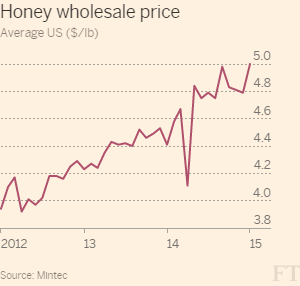US honey prices are continuing a steady upward trend with year-on-year prices in early February 13 per cent higher as a result of increased demand and lower domestic production.
Production of US honey has been falling year-on-year, with the latest figures from commodities data firm Mintec showing 67,800 tonnes of honey were produced in 2013, down 5 per cent year-on-year and 35 per cent lower than output levels of 20 years ago, mainly due to a decline in bee colony yields.
As a result of a supply and demand imbalance, imports into the US have been rising steadily, with volumes in 2013 reaching 153,750 tonnes, up 8 per cent year-on-year, and totalling about 65 per cent of US supply.
Mintec says: “The decline in production is due to a naturally occuring phenomenon named Colony Collapse Disorder in which worker honey bees disappear, resulting in a dead colony. This has casued not just a decline in honey production but also affected agricultural crops that need bees to pollinate fruit, vegetables and field crop flowers.”
The American Bee Journal reported that bee colonies continued to stream into drought-striken California from all over the country in January for the almond pollination season. Prices of $170 to $180 were being quoted for colonies with eight frames of brood, with bonuses for stronger hives.
Heavy rains in December helped soil moisture in California, which in turn should also help spring honey flows. A large reduction in fuel prices percolating through from lower oil prices has given a lift to migratory beekeepers.
Early winter storms caught beekeepers on the Eastern Seaboard by surprise. Many were still feeding colonies that were light on winter stores which could lead to higher winter losses. The Upper Midwest also received an early taste of winter, but elsewhere in the US snow has not been as heavy as last winter.
The Journal underlined that honey inventories remain low and that this has continued to keep both the wholesale and retail markets for honey strong.
President Barack Obama last summer announced plans to form a “Pollinator Health Task Force” in an attempt to save the dwindling population of bees.
Bee populations saw a 23 per cent decline in winter 2013-14, which is blamed on the loss of genetic diversity and exposure to certain pesticides. A quarter of foods eaten by Americans — including apples, carrots and avocados — rely on pollination, and the process carried out by the honey bee adds more than $15bn in value to agricultural crops each year in the US, the White House said.
Mr Obama ordered the creation of a team — of representatives from 15 different departments, including state, defence, interior and national security — to tackle the decline. The team is studying the current populations, looking at ways of improving habitat, and creating a public education plan. The US Department of Agriculture also directed an extra $8m toward a programme in some midwestern states to cultivate new habitats.
